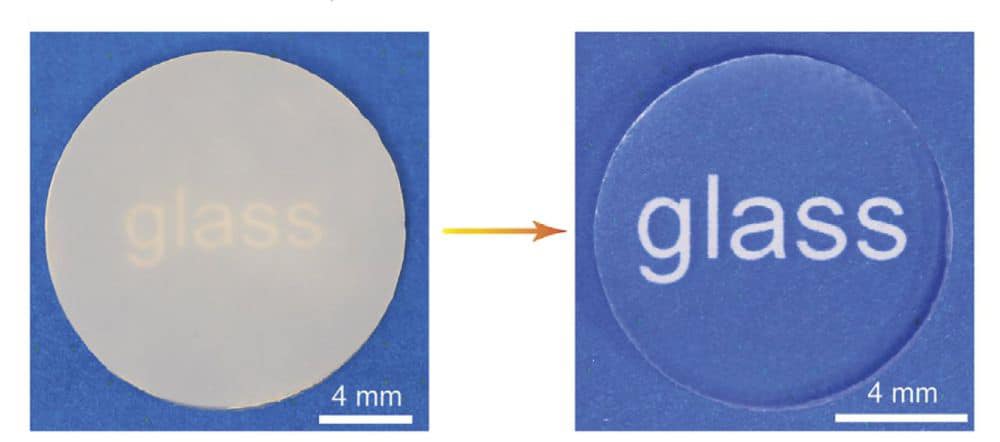
[Image above] Optical images of the starting glass powder compact (left) and ultrafast high-temperature sintered transparent pellet (right). Photo courtesy of Liangbing Hu.
With only a few months left in the 2022 International Year of Glass, now is the time to pivot from celebrating glass’s past to anticipating glass’s future. That not only includes exploring new compositions and applications but also improving glasses that already exist.
Synthesis of silica glass is one area researchers look to improve in the future. Silica glasses have wide applications in industrial fields due to their desirable properties, including high transparency, low thermal expansion coefficient, and high hardness. However, current methods of fabricating silica glass can be expensive and slow.
“Conventionally, silica glasses are manufactured by melting natural crystalline quartz or silicon compound precursors at high temperatures from 2273 to 2573 K [~3,630–4,170°F], followed by quenching. However, this traditional melting method requires a high energy input to reach the required temperature due to the high melting point of pure silica (≈2000 K),” researchers write in a recent paper. “Conventional solid-state sintering can reduce the processing temperature but requires hours-long thermal treatment to obtain dense silica glasses.”
The authors of the recent paper come from the University of Maryland, Alfred University, and the University of California, San Diego. They are led by University of Maryland professor Liangbing Hu and ACerS Fellows Yiquan Wu (Alfred professor) and Jian Luo (UC San Diego professor).
They explain that new sintering methods such as spark plasma sintering, flash sintering, and laser sintering demonstrate potential for addressing some of the silica glass manufacturing challenges, but they face limitations as well. Thus, researchers continue to search for alternative glass synthesis techniques.
In the recent paper, the joint team of Hu, Wu, and Luo describe using an ultrafast high-temperature sintering (UHS) method to achieve rapid, pressureless sintering of silica glass.
The UHS method is one Hu and Luo previously developed and used to rapidly synthesize and sinter solid-state electrolytes, metals, phosphor converters, and ceramics. It involves sandwiching a pressed green pellet of precursor powders between two strips of carbon and then quickly heating the pellet through radiation and conduction. Compared to other sintering methods, the UHS method
- Prevents volatile evaporation and undesirable interdiffusion due to a short sintering time, unlike conventional sintering.
- Allows general and rapid synthesis and sintering of a broad range of ceramic and metallic materials by decoupling intrinsic properties of the material (such as the electric response) from the process, unlike flash sintering.
- Enables the potential for scalable, roll-to-roll sintering of materials because the precursor film can quickly pass through the heating strips.
- Is compatible with 3D printing of ceramic precursors, unlike spark plasma sintering.
For this study, the researchers placed a pressed pellet of amorphous silica nanoparticles (average particle size of 11 nm) in direct contact with the carbon heater. They then heated the pellet to about 1600 K in approximately 10 seconds, after which they held the pellet isothermally for 10 seconds before rapidly cooling the pellet down at a rate of up to 102 K/s.
Before the UHS process, the precursor pellet had a low relative density of about 35% and was semitransparent due to the uniformly distributed nanopores between the nanoparticles. However, after sintering, the silica glass exhibited relative densities of more than 98% and had a visible transmittance of about 90% in a wide wavelength range (400–1,000 nm).
The researchers compared the flexural strength of the UHS glass to a commercial float glass slide using a three-point bending test. The measured flexural strength of the sintered glass was about 70 MPa, which was comparable with that of commercial float glass (~58 MPa), thus indicating “that the fast cooling does not undermine the mechanical properties of the sintered glass by UHS,” they write.
To further explore the effects of sintering silica glass with the UHS process, the researchers ran several additional experiments with different sintering parameters. They found the UHS process could densify micro silica powder (average particle size of 44 μm) to a relative density of more than 98% at 1600 K for 5 seconds. The UHS process also allowed rapid doping of metal ions to develop colored or rare earth element doped glasses.
“The work has successfully demonstrated the UHS proof‐of‐concept for the rapid processing of silica glass and can be further extended to sinter other functional glasses and transparent materials,” Wu says in an email. “Importantly, the UHS technique can be developed into a high-throughput experimental platform, as one of the key components to the success of glass materials informatics.”
The paper, published in Small, is “Rapid pressureless sintering of glasses” (DOI: 10.1002/smll.202107951).
